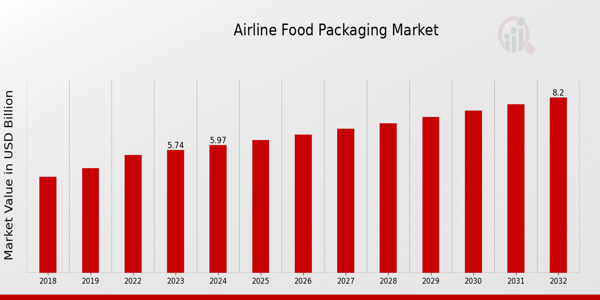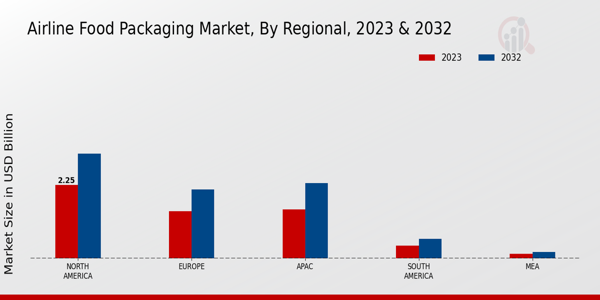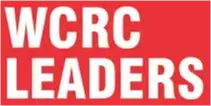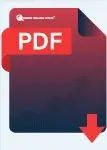Global Airline Food Packaging Market Overview
The Airline Food Packaging Market Size was estimated at 5.52 (USD Billion) in 2022. The Airline Food Packaging Industry is expected to grow from 5.74(USD Billion) in 2023 to 8.2 (USD Billion) by 2032. The Airline Food Packaging Market CAGR (growth rate) is expected to be around 4.04% during the forecast period (2024 - 2032).
Key Airline Food Packaging Market Trends Highlighted
The Airline Food Packaging Market is currently shaped by several key market drivers that include the growing demand for innovative and sustainable packaging solutions. Airlines are increasingly focused on enhancing passenger experience and satisfaction, leading to a trend towards eco-friendly materials that minimize environmental impact. Waste reduction and efficient packaging designs are becoming essential due to rising awareness about sustainability. The need for compliance with food safety regulations also drives the market, making quality packaging crucial in ensuring the safety and freshness of in-flight meals. Opportunities in the market can be explored through the adoption of advanced technologies such as smart packaging.This includes features like QR codes that provide information about meal preparation and sourcing, appealing to a tech-savvy consumer base. Additionally, customization of packaging to cater to dietary preferences and regional cuisines could become a significant market differentiator. Collaborations between airlines and packaging suppliers are also paving the way for innovative solutions that enhance operational efficiency while maintaining high food quality. In recent times, there has been a noticeable shift towards plant-based and organic food offerings, impacting the design and composition of food packaging. Airlines are embracing this trend to cater to changing consumer preferences and promote health-conscious options.Furthermore, the COVID-19 pandemic has accelerated the demand for single-use packaging as airlines aim to ensure hygiene and safety in meal service. Overall, the combination of sustainability, innovation, and evolving consumer tastes is playing a pivotal role in redefining the Airline Food Packaging Market.

Source: Primary Research, Secondary Research, MRFR Database and Analyst Review
Airline Food Packaging Market Drivers
Increasing Passenger Travel and ization Effects
The packaging market in the airline food industry is mostly influenced by the rise in international travel, which is also a byproduct of ization. The increasing number of air passengers every year has run the airlines and their services on expansion, which calls for food packaging solutions on a larger scale for airlines. With the world becoming ised, now more than ever, people have the need to travel for business or leisure, which means that there is a need for more in-flight meals.Enhanced competition among airlines to provide high-quality service, including food and beverage offerings, allows them to differentiate themselves in a crowded market. This focus on in-flight experience compels airlines to invest in effective and sustainable food packaging that ensures food safety, maintains temperature, and appeals visually to consumers. Rising environmental concerns have also prompted airlines to seek out eco-friendly packaging options, leading to innovations within the Airline Food Packaging Market Industry.These changes not only cater to evolving consumer preferences but also align with sustainability goals, positively affecting the growth trajectory of the market as airlines aim to reduce their carbon footprint through responsible sourcing and efficient packaging solutions. The combined impact of increasing travel and the need for sustainable practices is positioning the Airline Food Packaging Market Industry for substantial growth in the coming years, making it crucial for market players to stay ahead of shifting trends and preferences.
Technological Advancements in Food Packaging Solutions
Technological advancements play a vital role in shaping the Airline Food Packaging Market Industry. Innovations in materials, design, and food preservation techniques have made packaging more efficient and effective. For instance, the introduction of temperature-controlled packaging allows airlines to serve meals that remain fresh and safe for consumption over longer durations. Additionally, smart packaging solutions are providing airlines with valuable data on food quality and safety, enhancing operational efficiency.The trend towards minimalism in design also complements consumer preferences for aesthetic appeal while maintaining functionality. By harnessing new technologies, airlines can present meals in a more appealing manner, thereby improving customer satisfaction and loyalty. As technology continues to evolve, the possibilities for enhancing the in-flight dining experience will only expand, providing significant growth opportunities within the Airline Food Packaging Market Industry.
Regulatory Compliance and Food Safety Standards
Regulatory compliance and food safety standards are increasingly becoming a critical driver for the Airline Food Packaging Market Industry. Airlines must adhere to stringent regulations to ensure that food offered on flights meets safety requirements, which in turn affects the choice of packaging materials and processes. Meeting these standards is essential not only for passenger safety but also for maintaining brand reputation. As the Airline Food Packaging Market Industry evolves, an emphasis on quality assurance and transparency in sourcing has emerged.As a result, manufacturers are increasingly developing specialized packaging solutions that adhere to industry standards while also considering consumer preferences for sustainability and health. This growing focus on compliance is likely to propel market growth as stakeholders seek packaging options that balance regulatory requirements with consumer demands and corporate social responsibility initiatives.
Airline Food Packaging Market Segment Insights
Airline Food Packaging Market Material Type Insights
The Airline Food Packaging Market shows a diverse landscape when it comes to Material Type segmentation, encompassing several key materials that cater to the unique demands of airline food service. In 2023, the market valuation reflects a total worth of 5.74 USD Billion, with the material types being pivotal in driving this growth. The largest segment is Plastic, which holds a significant share valued at 2.28 USD Billion and is expected to rise to 3.2 USD Billion by 2032. This material is prevalent in airline food packaging due to its lightweight nature and versatility, making it an ideal choice for in-flight meals. Following closely is the Metal segment, valued at 1.2 USD Billion in 2023, which is projected to increase to 1.85 USD Billion by 2032. Metal packaging is known for its strength and ability to preserve food under various conditions, thus holding a vital role in airline catering.
Paper packaging, valued at 1.1 USD Billion in 2023 and anticipated to reach 1.55 USD Billion by 2032, captures attention due to its eco-friendliness and recyclability, gaining interest amidst the rising sustainability trends in the industry. In contrast, Biodegradable Materials, starting from a valuation of 0.95 USD Billion in 2023 and moving to 1.3 USD Billion in 2032, reflect the growing consumer demand for sustainable options, thereby offering airlines opportunities to enhance their green credentials and attract environmentally-conscious travelers. Lastly, the Glass segment, though comparatively smaller with a valuation of 0.21 USD Billion in 2023 and predicted to rise to 0.3 USD Billion by 2032, is utilized mainly for premium offerings, capitalizing on an upscale presentation and adequate food preservation features.
Collectively, these material types exhibit varied importance within the airline food packaging industry, with plastic demonstrating the majority holding due to its practicality and functionality, while biodegradable materials gain traction in response to environmental pressures. As the Airline Food Packaging Market continues to evolve, it will be essential for stakeholders to navigate the balancing act of cost, sustainability, and the imperative of maintaining high food quality standards amidst growing demand. This material segmentation reflects the dynamic nature of consumer preferences, industry standards, and innovations aimed at enhancing the overall travel experience.

Source: Primary Research, Secondary Research, MRFR Database and Analyst Review
Airline Food Packaging Market Product Type Insights
This market encompasses several key categories, including trays, containers, cups, cutlery and wrapping materials. Trays play a significant role due to their ability to facilitate organized meal presentation, which enhances the passenger experience. Containers are also crucial as they ensure the safe transportation of diverse food items, maintaining freshness and quality during flights.Additionally, cups are essential for serving beverages and are often designed to be stackable for efficient storage. Cutlery is important not only for functionality but also for the branding opportunities it provides for airlines. Wrapping materials, while often overlooked, significantly contribute to food safety and hygiene, which are paramount in airline services. Overall, the diverse product types within the Airline Food Packaging Market segmentation highlight the importance of tailored solutions that meet both consumer expectations and regulatory standards, thereby driving market growth and providing numerous opportunities in this dynamic industry.
Airline Food Packaging Market End Use Insights
Each of these categories contributes to the market's expansion, with first-class packaging often designed for luxury and premium experiences, utilizing high-quality materials that align with elevated customer expectations. Business Class provides a balance of quality and functionality, catering to professionals who prioritize convenience and sophistication during travel.Economy Class packaging focuses on cost-effectiveness without compromising basic quality, making it a significant volume-driving segment in the market. The increasing demand for diverse meal options and sustainable packaging solutions across these classes is fueling market growth, while challenges such as regulatory compliance and cost management present hurdles. Overall, the segmentation within the Airline Food Packaging Market illustrates the varying requirements and preferences of airline passengers, enhancing the overall travel experience as airlines strive to differentiate their services.
Airline Food Packaging Market Distribution Channel Insights
The segmentation within this market encompasses Direct Sales, Distributors and Online Sales, each playing a crucial role in the overall supply chain. Direct Sales is particularly vital as it allows for personalized service and stronger relationships between suppliers and airlines. Meanwhile, Distributors serve as significant intermediaries, facilitating logistics and ensuring that packaging reaches airlines efficiently.Online Sales have gained traction, driven by the e-commerce boom, providing a convenient platform for customers to procure packaging solutions. These channels contribute substantially to the Airline Food Packaging Market revenue, showcasing a dynamic landscape where businesses must adapt to evolving consumer preferences and technological advancements. The increasing focus on sustainability and enhanced passenger experience further stimulates growth opportunities within these channels, with industry players leveraging innovative packaging designs to capture market share.
Airline Food Packaging Market Regional Insights
The Regional segment of the Airline Food Packaging Market reflects significant market dynamics that underscore its importance in the overall industry. In 2023, North America led with a valuation of 2.25 USD Billion, showcasing a majority holding in regional revenue, primarily due to a high volume of air travel and substantial investments in airline services. Europe follows with a valuation of 1.45 USD Billion, emphasizing its relevance as a strong market driven by the demand for upscale in-flight meals and eco-friendly packaging options.The APAC region holds a valuation of 1.5 USD Billion, reflecting rapid growth attributed to the increasing air traffic and evolving consumer preferences toward quality airline food experiences. Meanwhile, South America, valued at 0.4 USD Billion, is emerging steadily, with a focus on enhancing airline services to attract more passengers. The Middle East and Africa (MEA) is the least dominant segment, valued at 0.14 USD Billion, yet it presents opportunities with ongoing airline expansions in the region. The Airline Food Packaging Market data indicates that each region plays a crucial role in addressing unique challenges and market growth opportunities, driven by varying passenger demands and airline strategies, thus contributing to an evolving competitive landscape.

Source: Primary Research, Secondary Research, MRFR Database and Analyst Review
Airline Food Packaging Market Key Players and Competitive Insights
The Airline Food Packaging Market is characterized by rapid growth and innovation due to evolving consumer preferences and regulatory demands. As the aviation industry continues to recover from the disruptions caused by events, the need for sustainable and efficient food packaging solutions has risen significantly. Key players in this market are increasingly leveraging advanced materials to enhance the passenger experience, focusing on convenience, safety, and eco-friendliness. The significance of branding through packaging and the optimization of food waste management are also critical factors driving competition. Differentiation and strategic collaboration with airlines are essential aspects that market players need to consider to maintain a competitive edge in this dynamic environment.Sky Chefs holds a prominent position within the Airline Food Packaging Market by utilizing its extensive experience and footprint. The company is known for its commitment to quality and innovation, providing packaging solutions that prioritize freshness, safety, and sustainability. With a focus on delivering exceptional culinary experiences in the air, Sky Chefs has invested in advanced packaging technologies that not only preserve food quality but also minimize waste. Their strategic partnerships with airlines enable tailored solutions that meet the specific needs of different carriers, enhancing overall customer satisfaction. Furthermore, Sky Chefs emphasizes the use of recyclable materials in its packaging processes, aligning with the increasing consumer demand for environmentally responsible practices. This proactive approach has solidified Sky Chefs' reputation as a leader in the airline food packaging segment.Collective Brands has emerged as an influential player in the Airline Food Packaging Market, known for its adaptability and innovative packaging solutions that cater to the unique requirements of airlines. The company stands out for its focus on developing products that enhance the entire inflight dining experience. Collective Brands emphasizes the creation of visually appealing and functional packaging that not only preserves the integrity of the meals but also resonates with modern travelers' tastes and expectations. Their strength lies in the ability to provide customizable packaging options, which allow airline partners to elevate their brand identity and improve passenger interaction with the food served onboard. The company is also dedicated to sustainable practices, consistently seeking ways to incorporate biodegradable and eco-friendly materials into their offerings. This focus on quality, adaptability, and sustainability positions Collective Brands as a strong contender in the competitive landscape of airline food packaging.
Key Companies in the Airline Food Packaging Market Include
- Sky Chefs
- Collective Brands
- Gate Gourmet
- Flying Food Group
- Air France KLM Catering
- Food Service Partners
- Royal Catering
- LSG Group
- Newrest
- Royal Air Maroc Catering
- Servair
- SATS Ltd
- Air Gourmet
- DO and CO
- Aviapartner
Airline Food Packaging Market Industry Developments
Recent developments in the Airline Food Packaging Market have shown a noticeable focus on sustainability and innovation as airlines seek eco-friendly materials for meal packaging. Companies like Sky Chefs and Gate Gourmet are actively exploring biodegradable and recyclable solutions to minimize environmental impact.
Additionally, the growing trend of customizing in-flight dining experiences has led to an increase in demand for high-quality packaging that maintains food freshness and presentation. The market has witnessed several strategic partnerships aimed at enhancing service delivery; for instance, Food Service Partners and LSG Group have joined forces to expand their operational capabilities. In terms of ongoing transactions, there are notable mergers and acquisitions on the horizon as key players like Newrest and Air Gourmet look to bolster their market positions through strategic consolidations. The overall market valuation is projected to rise significantly, driven by increasing air travel and heightened consumer expectations for quality meals onboard. This surge not only boosts the financial health of companies such as Flying Food Group and Royal Catering but also pushes the industry toward technological advancements in food packaging solutions, further enhancing the passenger experience during flights.
Airline Food Packaging Market Segmentation Insights
Airline Food Packaging Market Material Type Outlook
- Plastic
- Metal
- Paper
- Biodegradable Materials
- Glass
Airline Food Packaging Market Product Type Outlook
- Trays
- Containers
- Cups
- Cutlery
- Wrapping Materials
Airline Food Packaging Market End Use Outlook
- First Class
- Business Class
- Economy Class
Airline Food Packaging Market Distribution Channel Outlook
- Direct Sales
- Distributors
- Online Sales
Airline Food Packaging Market Regional Outlook
- North America
- Europe
- South America
- Asia Pacific
- Middle East and Africa
| Report Attribute/Metric |
Details |
| Market Size 2022 |
5.52(USD Billion) |
| Market Size 2023 |
5.74(USD Billion) |
| Market Size 2032 |
8.2(USD Billion) |
| Compound Annual Growth Rate (CAGR) |
4.04% (2024 - 2032) |
| Report Coverage |
Revenue Forecast, Competitive Landscape, Growth Factors, and Trends |
| Base Year |
2023 |
| Market Forecast Period |
2024 - 2032 |
| Historical Data |
2019 - 2023 |
| Market Forecast Units |
USD Billion |
| Key Companies Profiled |
Sky Chefs, Collective Brands, Gate Gourmet, Flying Food Group, Air France KLM Catering, Food Service Partners, Royal Catering, LSG Group, Newrest, Royal Air Maroc Catering, Servair, SATS Ltd, Air Gourmet, DO and CO, Aviapartner |
| Segments Covered |
Material Type, Product Type, End Use, Distribution Channel, Regional |
| Key Market Opportunities |
1. Sustainable packaging materials, 2. Innovative design solutions, 3. Enhanced regulatory compliance, 4. Growing demand for premium offerings, 5. Expansion in emerging markets |
| Key Market Dynamics |
1. Sustainability trends, 2. Regulatory compliance, 3. Cost efficiency, 4. Customization demands, 5. Health and safety standards |
| Countries Covered |
North America, Europe, APAC, South America, MEA |
Frequently Asked Questions (FAQ) :
The Airline Food Packaging Market is expected to reach a value of 8.2 billion USD by 2032.
The market is anticipated to grow at a CAGR of 4.04% from 2024 to 2032.
North America is projected to hold the largest market share, valued at 3.2 billion USD in 2032.
The plastic segment is expected to be valued at 3.2 billion USD in 2032.
Key players include Sky Chefs, Gate Gourmet, and LSG Group, among others.
The metal segment is expected to be valued at 1.85 billion USD in 2032.
The APAC region is projected to value 2.3 billion USD by 2032.
The biodegradable materials segment is expected to be valued at 1.3 billion USD by 2032.
The paper segment is anticipated to reach 1.55 billion USD by 2032.
Challenges may include environmental regulations and rising material costs impacting the market growth.





























